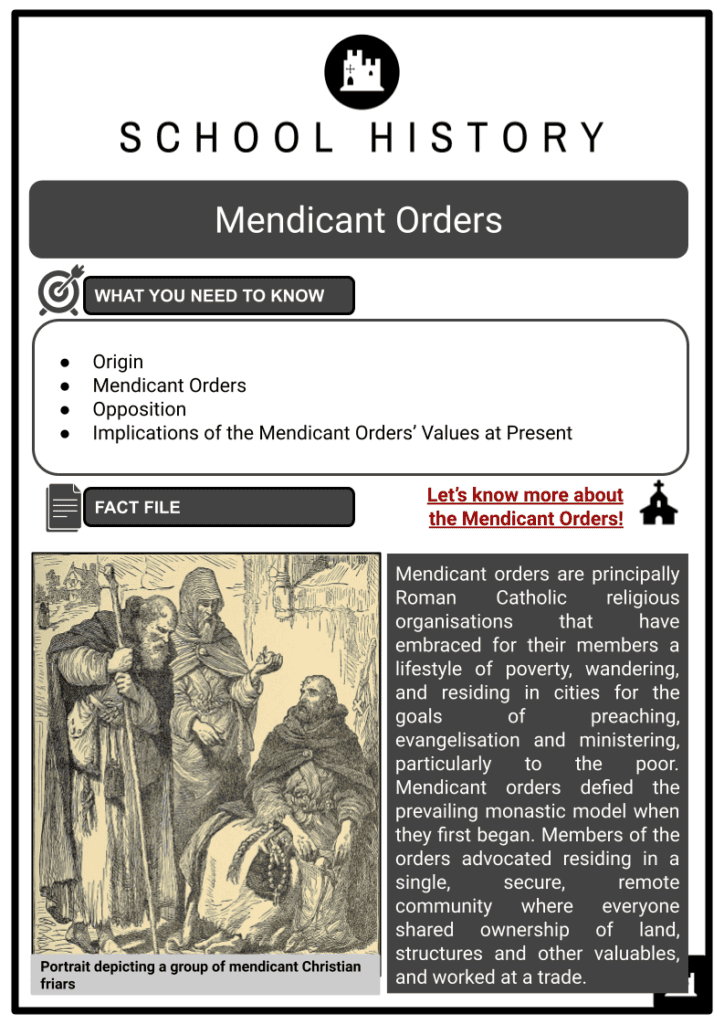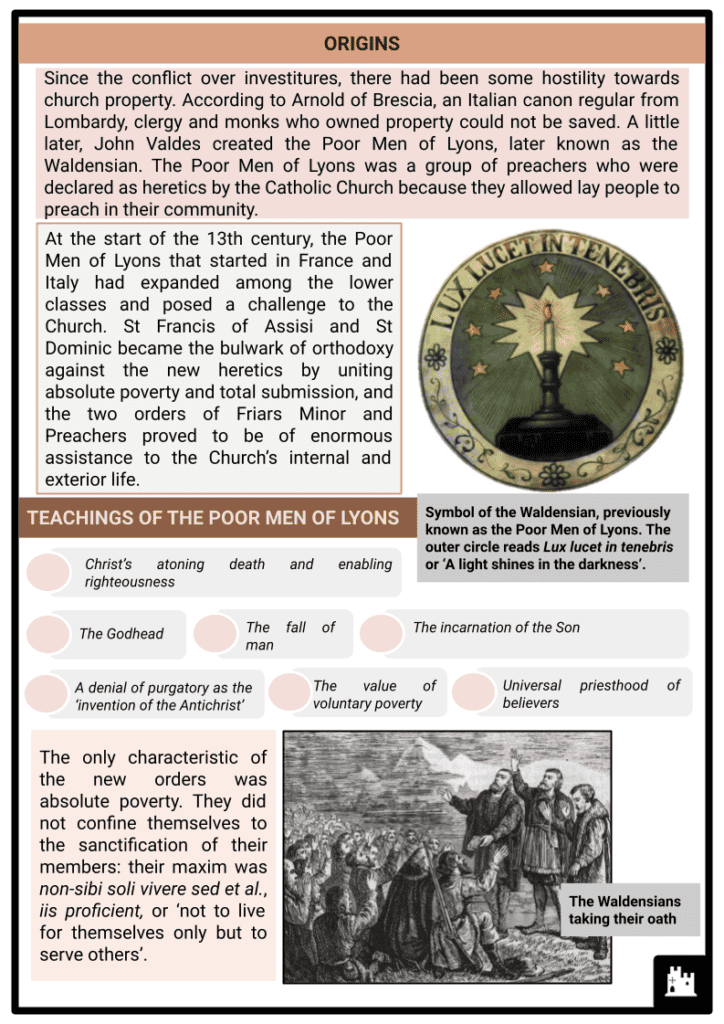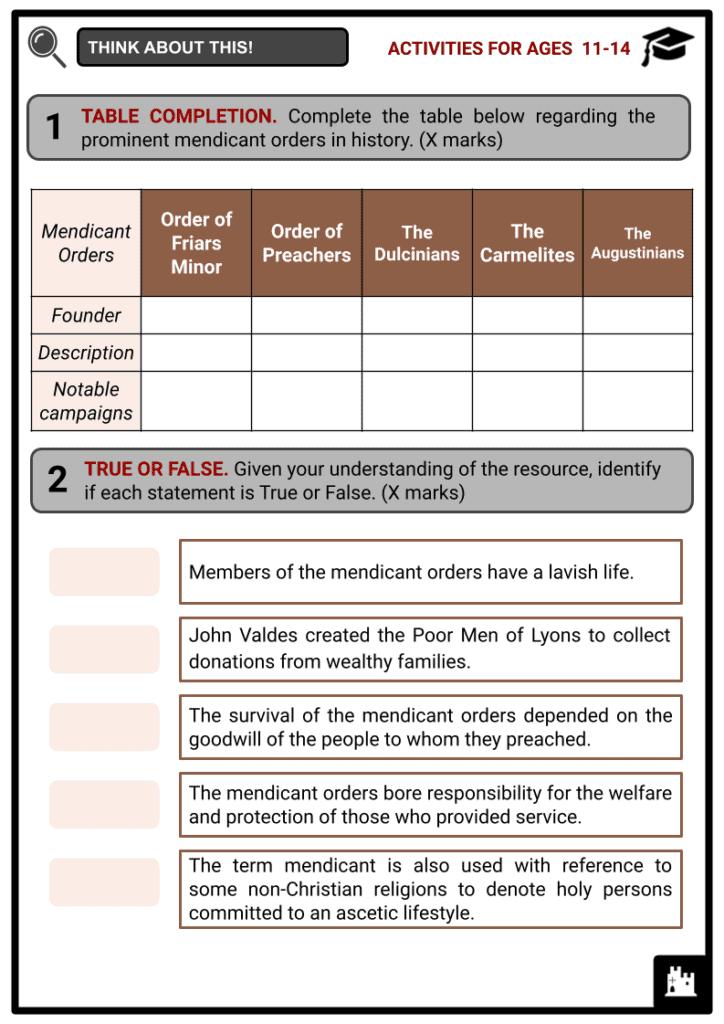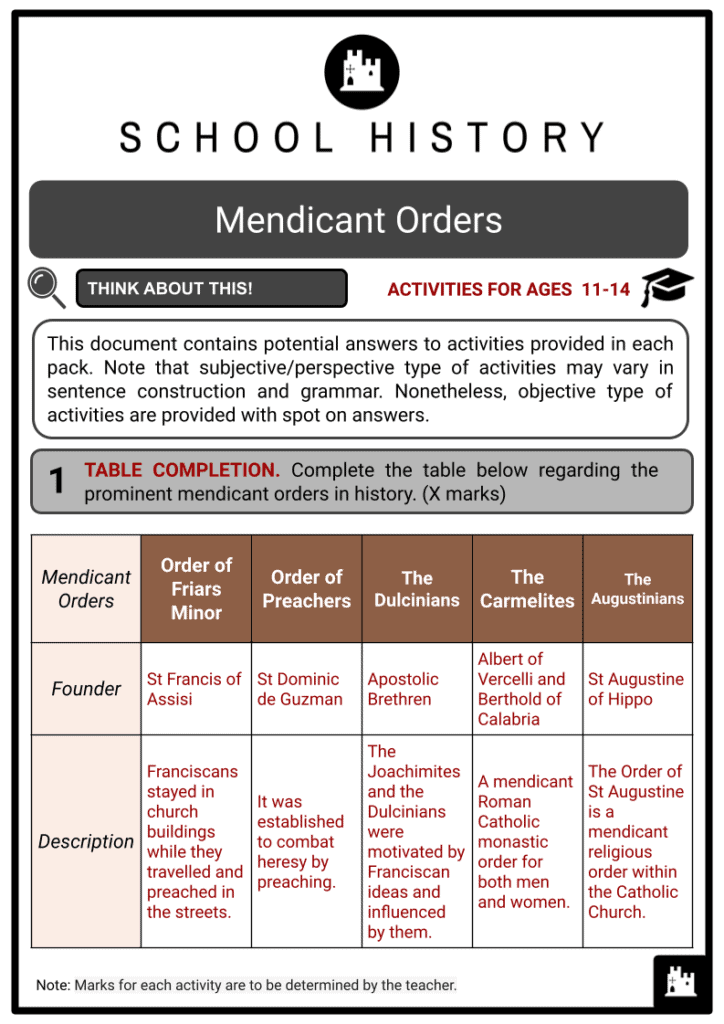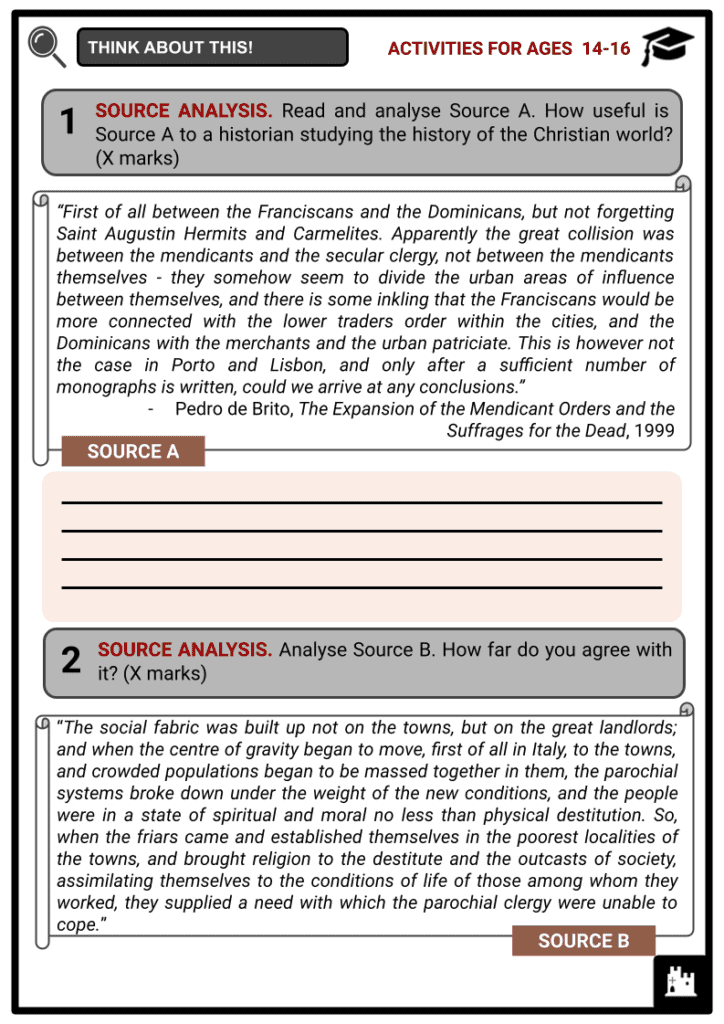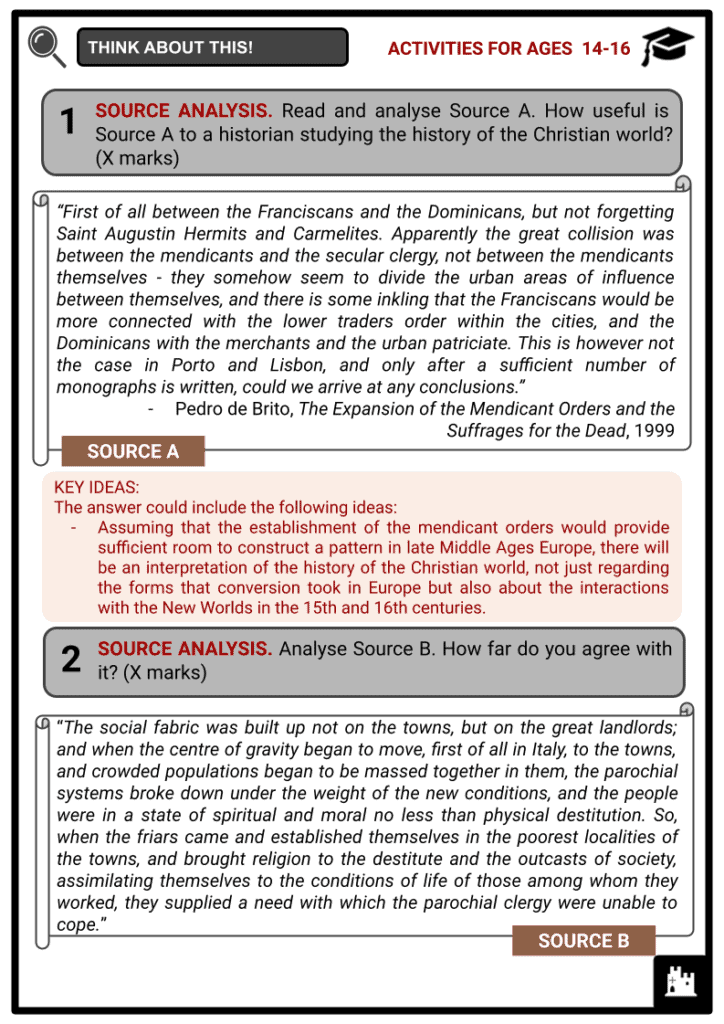Mendicant Orders Worksheets
Do you want to save dozens of hours in time? Get your evenings and weekends back? Be able to teach about the Mendicant Orders to your students?
Our worksheet bundle includes a fact file and printable worksheets and student activities. Perfect for both the classroom and homeschooling!
Summary
- Origin
- Mendicant Orders
- Opposition
- Implications of the Mendicant Orders’ Values at Present
Key Facts And Information
Let’s know more about the Mendicant Orders!
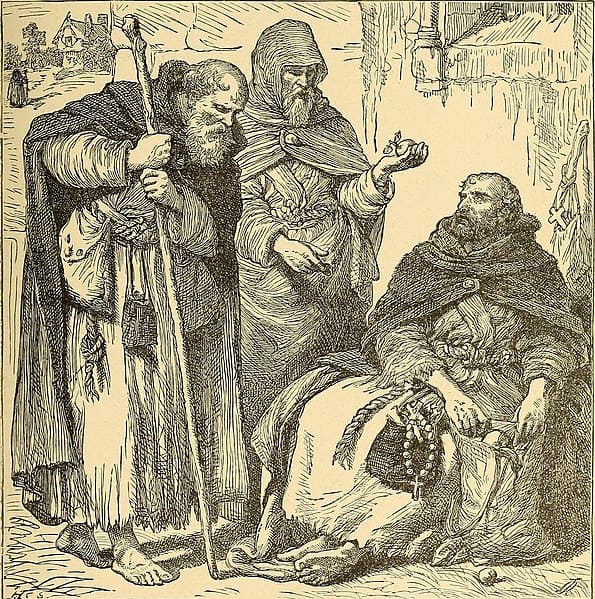
Mendicant orders are principally Roman Catholic religious organisations that have embraced for their members a lifestyle of poverty, wandering, and residing in cities for the goals of preaching, evangelisation and ministering, particularly to the poor. Mendicant orders defied the prevailing monastic model when they first began. Members of the orders advocated residing in a single, secure, remote community where everyone shared ownership of land, structures and other valuables, and worked at a trade.
ORIGINS
- Since the conflict over investitures, there had been some hostility towards church property. According to Arnold of Brescia, an Italian canon regular from Lombardy, clergy and monks who owned property could not be saved. A little later, John Valdes created the Poor Men of Lyons, later known as the Waldensian. The Poor Men of Lyons was a group of preachers who were declared as heretics by the Catholic Church because they allowed lay people to preach in their community.
- At the start of the 13th century, the Poor Men of Lyons that started in France and Italy had expanded among the lower classes and posed a challenge to the Church. St Francis of Assisi and St Dominic became the bulwark of orthodoxy against the new heretics by uniting absolute poverty and total submission, and the two orders of Friars Minor and Preachers proved to be of enormous assistance to the Church’s internal and exterior life.
TEACHINGS OF THE POOR MEN OF LYONS
-
- Christ’s atoning death and enabling righteousness
- The Godhead
- The fall of man
- The incarnation of the Son
- A denial of purgatory as the ‘invention of the Antichrist’
- The value of voluntary poverty
- Universal priesthood of believers
- The only characteristic of the new orders was absolute poverty. They did not confine themselves to the sanctification of their members: their maxim was non-sibi soli vivere sed et al., iis proficient, or ‘not to live for themselves only but to serve others’.
- Members of the Poor Men of Lyons joined the practice of the apostolic ministry, giving their time and energy to evangelising the masses, adding another aspect to monastic life while simultaneously being contemplative and active. Unlike those of the Benedictines, Cistercians and other monks generally, the mendicant convents were located in the towns where communal life was fast emerging as a necessary result of their intimate contact with the people from the beginning of the 13th century.
OUTCOMES OF COMMUNAL LIFE
-
- a new claustral organisation and the choice of a unique way of sustaining oneself
- form further features of the mendicant friars
- The mendicants enjoyed much more freedom than the monks, shackled by a vow of permanency to one convent.
Mendicant Orders
ORDER OF FRIARS MINOR
- Four primary mendicant orders were formed by the Second Council of Lyon and were founded in the first half of the 13th century:
- The Order of Friars Minor (Franciscans)
- The Order of Preachers (Dominicans)
- The Dulcinians
- The Carmelites (Order of the Brothers of the Blessed Virgin Mary of Mount Carmel)
- The Augustinians (Hermits of St Augustine)
- In 1209, Francis of Assisi created the Order of Friars Minor, a mendicant Catholic religious order. The order follows the spiritual practices and teachings of the founder and his principal associates and disciples, including Clare of Assisi, Anthony of Padua and Elizabeth of Hungary, among many others. Today’s most significant First Order in the Franciscan movement is the Order of Friars Minor.
- In 1182, St Francis was born in Assisi. He was a spendthrift in his youth, but a life-threatening illness forced him to make the decision to give up his ordinary life and devote himself to God. His father was not pleased with this decision, so he disinherited him. Francis took refuge in a half-ruined church called Our Lady of the Angels, which was given to him by a Benedictine abbot.
- Francis restored the church by means of alms, calling it Portiuncula or Little Legacy, where he built his first convent. Around 1207, Francis started preaching, and in 1209, he went to Rome to ask Pope Innocent III for permission to establish his Order. The original Saint Francis Rule, which the pope authorised, forbade property ownership and required members of the order to beg for food while preaching.
- Franciscans stayed in church buildings while they travelled and preached in the streets. In 1223 the final modification of the Saint Francis Rule, which was the need for members to live in great poverty, was loosened. The members’ level of observance continued to be a significant point of contention within the order, frequently leading to secessions.
ORDER OF PREACHERS
- Dominic de Guzman, later on known as St Dominic, established the mendicant order known as the Order of Preachers, sometimes referred to as the Dominican Order, around the beginning of the 13th century. It was established to combat heresy by the preaching and exemplary life of friars and priests who diligently studied the Bible.
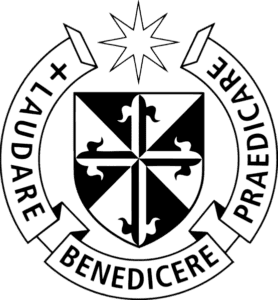
Coat of Arms of the Order of Preachers - During turbulent times when heresies were pervasive, and many people became oblivious to the truth of the Catholic faith, the Dominican Order was founded. The Bishop of Toulouse, France authorised the establishment of the first community of Dominic. Dominic then requested permission from Pope Innocent III to establish his community so that they might be licensed to preach outside of Toulouse.
- However, Pope Innocent III died and was succeeded by Honorius III. He immediately granted Dominic’s request and gave the order its blessing by issuing the bull Religiosam Vitam on 22 December 1216. The order’s membership developed to the point where dividing Dominicans into groups based on where they lived was essential. Provinces are the names given to these organisations. The General Chapters and Provincial Chapters are held on a regular basis because the Dominican Order values the democratic tradition it gained from St Dominic. Chapters are regular gatherings of Dominicans with the primary goal of debating significant issues and reaching a consensus.
THE DULCINIANS
- The Apostolic Brethren were the source of the religious group known as the Dulcinians, which emerged in the Late Middle Ages. The Dulcinians, sometimes known as Dulcinites, were motivated and influenced by Franciscan ideas, but the Catholic Church condemned them as heretics. The movement’s founder, Fra Dolcino of Novara, who was executed as a heretic by Pope Clement V, was the source of the group’s name.
THE CARMELITES
- The Carmelites are a mendicant Roman Catholic monastic order for both men and women. They are also commonly referred to simply as Carmel. Although historical sources on its founding still need to be made clear, historians claimed that it was most likely established on Mount Carmel in the Crusader States in the 12th century. Although Albert of Vercelli and Berthold of Calabria have generally been credited with founding the order, there aren’t many extant documents from the early Carmelite period. In 1452, the Carmelite Order became official.
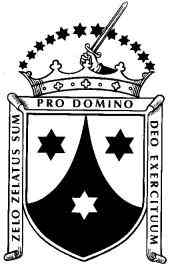
Coat of Arms of the Carmelites
ORDER OF ST AUGUSTINE
- The Order of St Augustine is a mendicant religious order within the Catholic Church. It was established in 1244 by merging numerous eremitical communities adhering to the Rule of St Augustine, organised by St Augustine of Hippo in the Tuscany region in the fifth century.
- Augustine of Hippo lived in a monastic community, initially with a few friends and then as a bishop with his clergy. Augustine did not alleviate poverty over sharing regarding the use of property or belongings. They inspired imitation because of the way they lived. Several of Augustine’s writings, particularly De opere monachorum, known as the Rule of St Augustine in ancient codices, provide instructions for their direction.
- Early mediaeval times saw the rule eclipsed by other rules, particularly the Rule of St Benedict. Still, this way of living for cathedral clergy persisted for centuries in various parts of Europe, earning them Canons Regular. In the 11th century, Augustine’s Rule reemerged in practice as the foundation for reforming monasteries and cathedral chapters.
OPPOSITION
- The new form of conventual life of the mendicant orders was met with solid opposition. The older orders opposed the chosen life of the mendicants. The rapid spread of the mendicants may be gathered from Chronica majora, a seminal work of Matthew Paris, a member of the English Benedictine community of St Albans and long-celebrated historian.
- The fact that St Francis owed the Benedictines for the Portiuncula, the first church of his order, is still widely acknowledged. The main opposition came from other sources, including the universities, bishops and non-religious clergy. The mendicants did not restrict themselves to the sacred ministry but, generally from the start, included intellectual individuals who asserted equality with other university doctors.
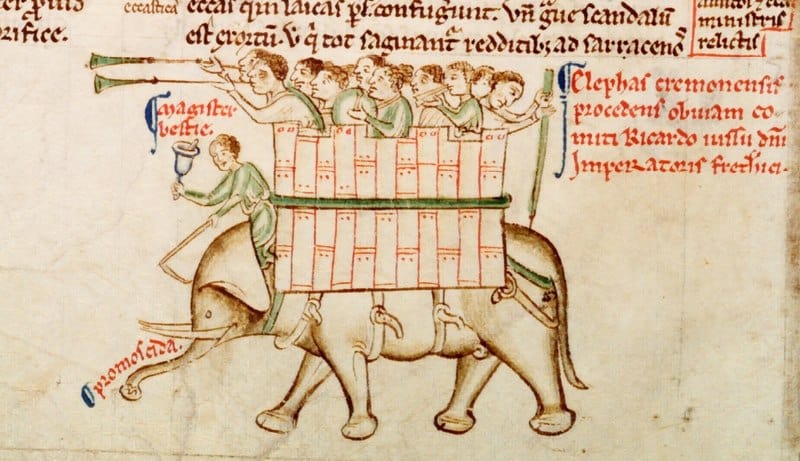
Elephant from Chronica majora - The Dominicans were the first religious order to include higher education as a particular point in their statutes, and just as the Dominicans are likely owed their mendicancy by St Francis’s influence over St Dominic, the Friars Minor are likely owed their higher education by the impact, or at the very least, by the Preachers’ example.
- However, the Church recognised the value of the new orders’ work. It exempted them from the bishops’ purview, giving them broad faculties for preaching and hearing confessions and the right to be buried in their churches – rights previously reserved for the secular clergy.
- It should be noted that this opposition was motivated by economic factors rather than just envy or other negative emotions. The parish priests relied heavily on contributions from the faithful, which threatened to decline their income due to the mendicant orders’ enormous popularity.
- Overall, it can be claimed that the Church stood up for the faithful against unfair attacks while also finding ways to correct wrongdoings that threatened the legitimate interests of the secular clergy. At the University of Paris and throughout France, there was a lot of antagonism towards the mendicants. In contrast, there was less unrest at Oxford University and in England. There was isolated opposition in other nations as well.
- Pope Gregory IX had to defend the mendicant orders against the pretensions of some prelates as early as 1231–32 who wanted the friars to be governed by them like the ordinary faithful.
- In England and Ireland, the conflicts between the mendicants and secular priests took a bitter turn in the 14th century. The case of Richard Fitzralph, Archbishop of Armagh, who spoke against the mendicants several times and criticised their poverty and privileges interfering with provincial rights in nine propositions, was an example of these conflicts between the mendicants and secular priests.
- The Wycliffite, followers of John Wycliffe, a biblical translator and Catholic priest, intensified and broadened their attacks on the mendicants in England towards the end of the 14th century. Initially, John Wycliffe did not have a negative relationship with the friars. His hatred was only present during his final years.
- Numerous such instances of antagonism against the friars, particularly the Minorites, existed in the 14th and 15th centuries. Although the Black Death and the Great Schism had negative impacts on their overall discipline, the mendicants, on the whole, thrived until the Reformation, thanks to the emergence of various other orders with stricter adherence. The mendicants have continued to play a significant role in the life of the Church up until the present, despite the significant losses they endured throughout that time.
IMPLICATIONS OF THE MENDICANT ORDERS’ VALUES AT PRESENT
- In the Catholic Church, generosity and fundraising are sometimes described in terms of the donor’s participation in contributions to the neighbourhood or society at large. Additionally, there may be references to religion, such as participation in the healing ministry of Christ.
Mendicant Orders’ VALUES
-
- Begging as Spiritual Practice
- Gifts between Friends
- But if one takes mendicant spirituality seriously, it forces the Catholic Church to adopt a more theological perspective on almsgiving. Whether or not the challenge is explicitly stated, this faith urges donors to understand that whatever they possess is a gift from God and must therefore be shared rather than hoarded. The implication is that using one’s riches to meet the needs of others is the finest way to recognise one’s talents. Such philanthropy isn’t charity or benevolence. Instead, it’s what one owes to one’s less fortunate friends and family as a matter of justice.
Image Sources
- https://www.wikiwand.com/en/File:The_story_of_our_Christianity;_an_account_of_the_struggles,_persecutions,_wars,_and_victories_of_Christians_of_all_times_(1893)_(14597327508).jpg
- https://en.wikipedia.org/wiki/File:EscOrdendePredicadores2Wikipedia.png
- https://en.wikipedia.org/wiki/File:K_znak.jpg
- https://en.wikipedia.org/wiki/File:Matthew_Paris_Elephant_from_Parker_MS_16_fol_151v.jpg

